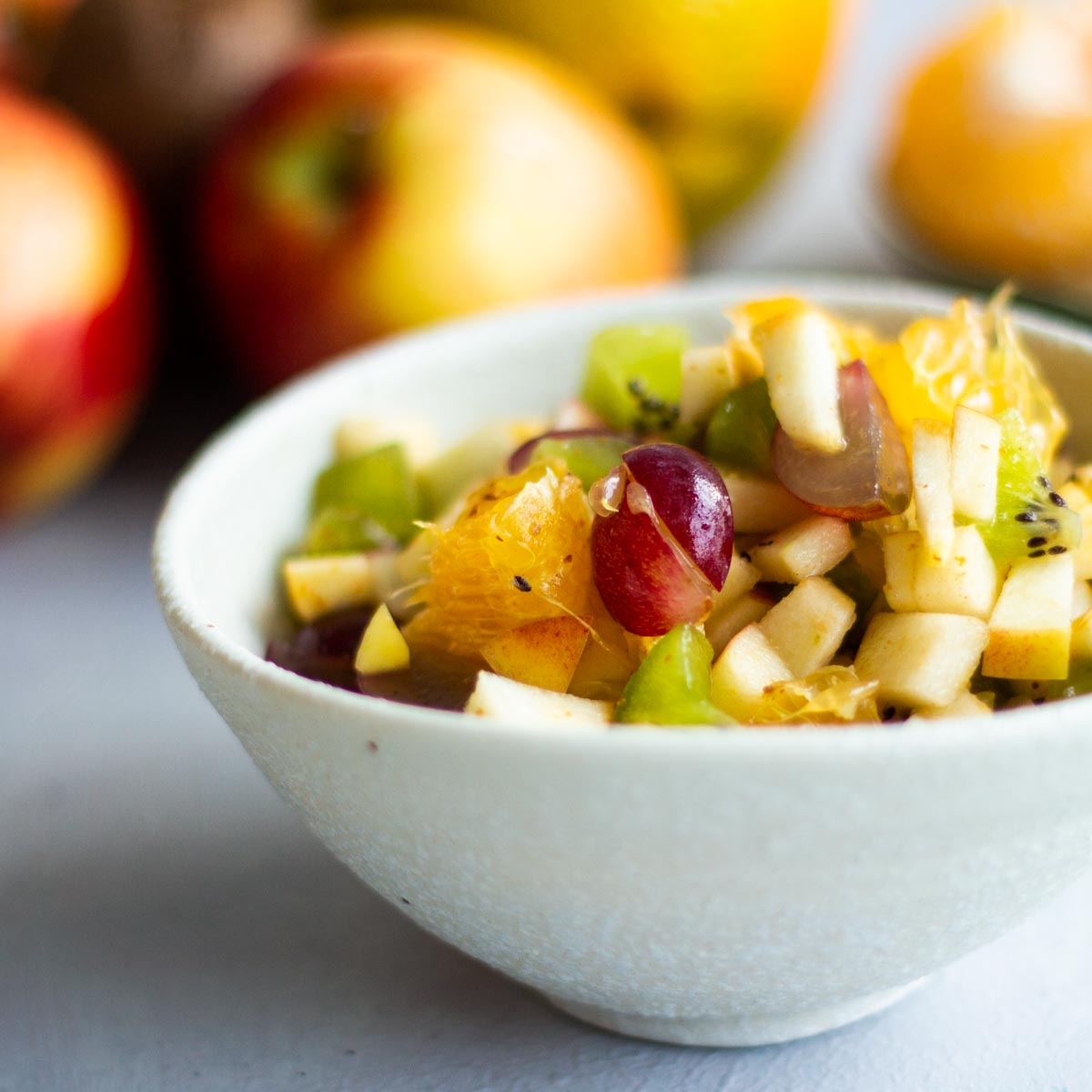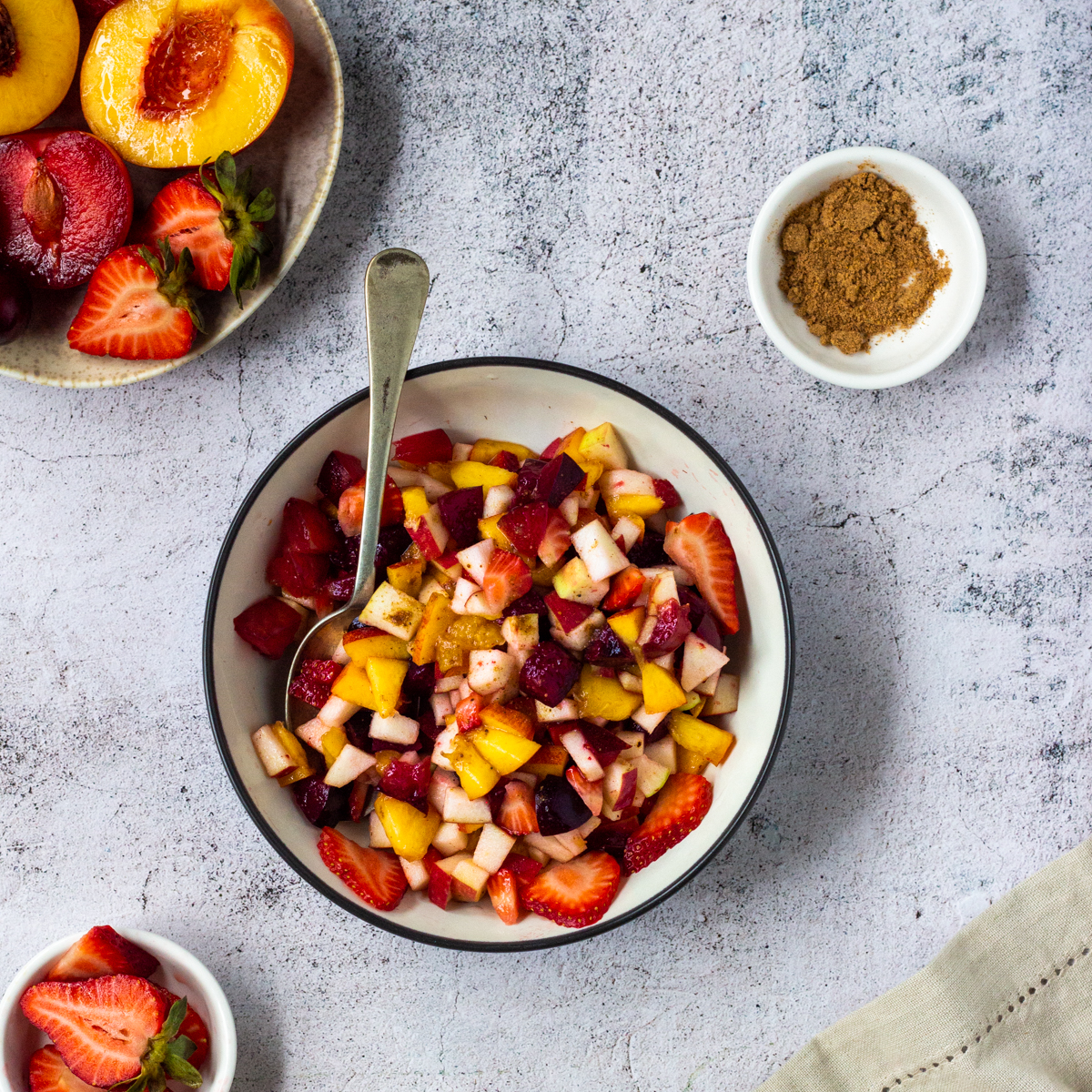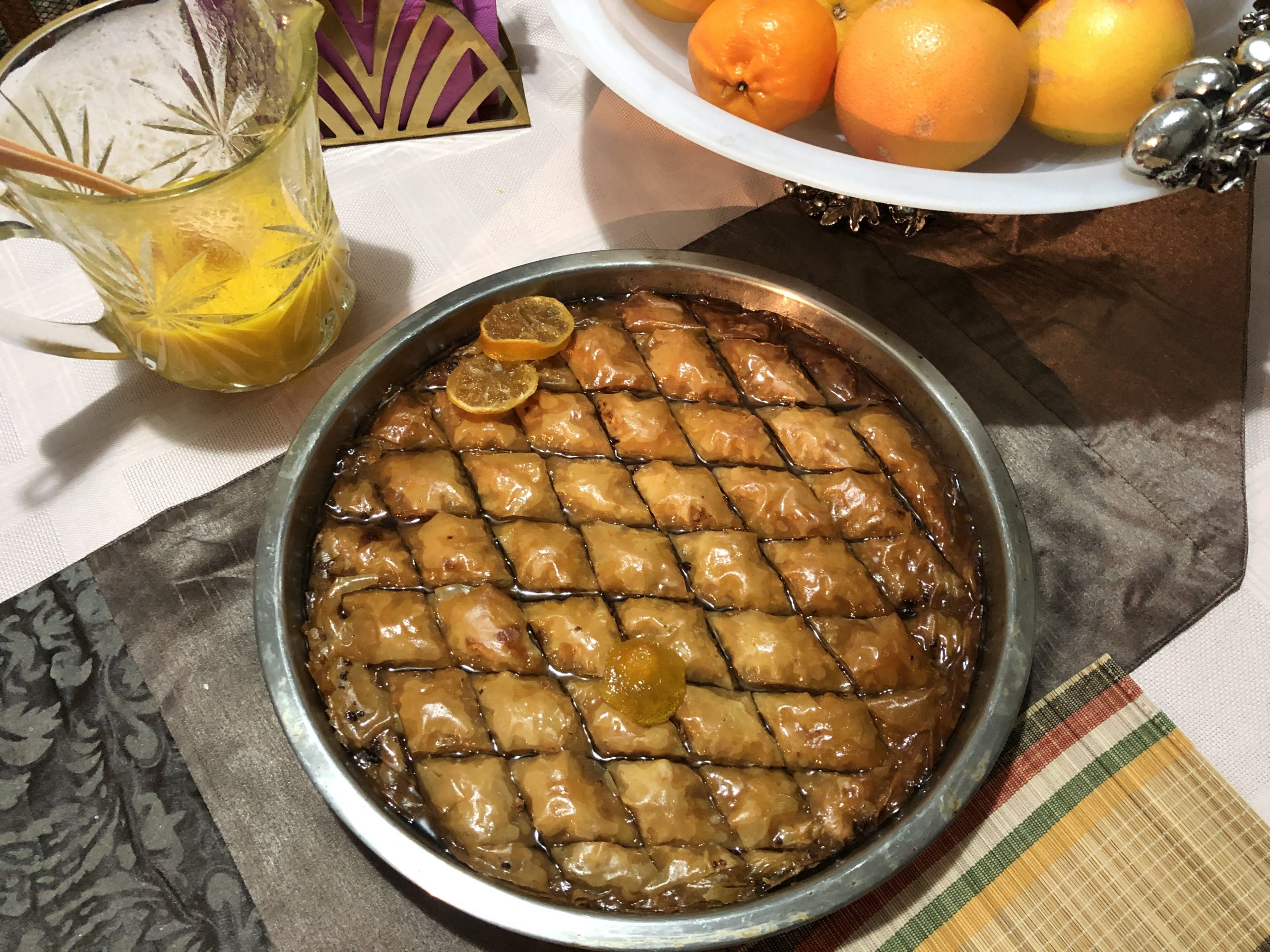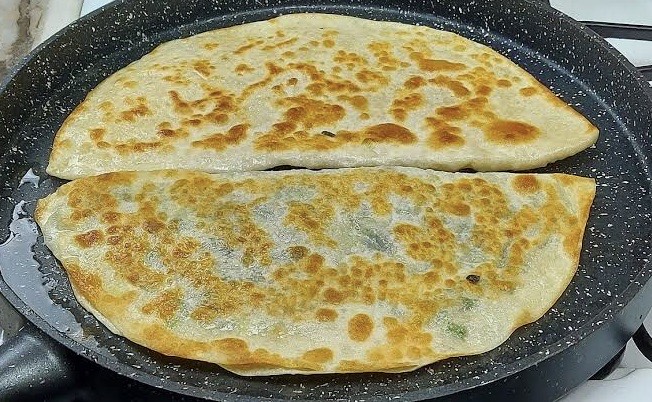Kiran’s Fruit Chaat
 Pakistan
Pakistan 
Fruit chaat, or spiced fruit chaat, is one of those essential dishes on every Pakistani iftar table in Ramadan. It’s super simple to make – just diced up seasonal fresh fruit tossed with salt, sugar, and chaat masala plus a squeeze of lemon to prevent the fruit from browning, and orange juice for a hint of tartness. Think of it as a refreshing palate cleanser to counter the other traditional Pakistani iftar fried items of pakoras, samosas, spring rolls, and chicken patties.
Chaat masala is the magical ingredient that transforms a simple fruit salad into something magical. It’s a spicy and tangy spice blend made using an assortment of spices which can include mango powder (amchur), black salt (kala namak), cumin seeds, red chili powder, salt, coriander seeds, or pomegranate seeds. It is used in Indian and Pakistani cuisine, mostly in street food dishes such as chana chaat (spicy chickpea salad) or aloo chana chaat (potato and chickpea salad) which are also popular items on the iftar table in Ramadan. It is also used as a seasoning salt sprinkled over fruits and vegetables such as apples, mangoes, cucumbers or boiled sweet potato (shakar kandi) – and in fruit chaat to add a hint of spice and tartness.
Chaat masala recipes vary from family to family, and depend on how the chaat masala will be used. Some will be spicier and savoury, and some will be tangy-er. My recipe is on the tangy and tart side, and is something I make every year before Ramadan starts. As the spices are roasted, the house is filled with a fragrant warmth-filled aroma. If you don’t have time to make your own, Chaat masala spice mix is fairly easy to buy in-store – in Pakistani and Indian grocery stores or in the international aisle of large supermarkets. Shan and National are brands that I regularly use. If you really don’t have time to make or buy the spice mix, you can substitute black pepper, salt and a little lemon juice.
Growing up, all of us siblings had roles and responsibilities assigned to us in the month of Ramadan. My first job was making Rooh Afza or laal sherbat (red squash), a refreshing and fragrant vibrant red cordial-based drink. The word for red in Urdu is laal hence why it’s called laal sherbat. Like fruit chaat, it’s another Ramadan staple in the Indian sub-continent.
Once I was old enough to properly use a knife and had figured out the basics of chopping, my mother gave me the responsibility of making fruit chaat. I would make it in the afternoon when the entire house was asleep, sitting on the dining table with an array of fruit in front of me while I watched a show on television. At first, the fruit was quite mismatched and disproportionate but as time went on, my fruit cutting skills became more uniform. I also became better at estimating the spices and seasoning to be added based on the amount of fruit that I cut. The thing with Ramadan is that since we are fasting, we can’t taste the food we’re preparing so it’s only when we take the first bite after we break the fast that we discover whether the sweetness level is correct.
Though I am sharing a recipe for fruit chaat below, it doesn’t strictly require a recipe. Every family has their version depending on personal preference and what fruit is in season. Some add twice as much apple, some add none. Some add fresh orange juice, and some add Tang (an orange-flavoured powdered drink that I have only seen in Pakistan and in the Middle East). Some love adding bananas, some won’t eat fruit chaat with bananas in it. Some will have two versions – one with bananas, one without. That was my bowl! I was never a banana fan.
In Pakistan, the most popular fruit for fruit chaat are guavas, pears, apples and bananas usually supplemented with seasonal fruit such as peaches, mangoes, grapes, pomegranate and melon based on the season Ramadan falls in. The Islamic calendar is based on the lunar calendar which is why the month of Ramadan moves forward by about two weeks every year.
In our family, our favourite fruit was guava (called amrood in Urdu) and when guavas were in season, our fruit chaat would just be made with guavas. Called amrood ki chaat or guava chaat.
My first Ramadan in Australia I couldn’t figure out what fruit to use because all the fruit in the supermarket was winter fruit and the varieties so different and exotic compared to what I was used to growing up in Karachi. In Pakistan, apples are either red or green. Grapes have seeds. Fruits such as blueberries, raspberries, kiwi fruit, nectarines, black and red grapes aren’t common. Even the way fruit is purchased was different. In Pakistan, fruit is purchased by the kilogram – no one buys just one apple!

Even though things were different here, I still had to have fruit chaat at my Iftar table so I experimented with different types of fruits and would cycle through different varieties of fruits at the supermarket till I found my favourite one. This is what I have learnt about making fruit chaat in Australia:
Out of all the apples available, pink lady works best. It’s crisp and firm and has the right tang to sweetness ratio. Just add lemon juice so it doesn’t discolour. Pears don’t need to be peeled but they do need to be ripe and sweet. Stone fruit like nectarines and peaches are delicious in a fruit chaat. Nectarines don’t need to be peeled but peaches can be peeled if you don’t like the slightly furry skin. They should be not too firm not too soft. Kiwi fruit adds a lovely hint of green. When adding grapes cut them in half or quarters. Use a mix of grapes (red, black and green) for colour. If you are lucky, guavas are available at Pakistani or Asian stores. They are pricier, but worth the expense once in a blue moon for the memories they evoke.
Lastly, there are no rules in fruit chaat. Feel free to experiment and find your favourite fruit combination.
Below is the recipe for fruit chaat I’ll be making this Ramadan with fruits in season in Australia in April. Do try it.
Fruit chaat is also a great way to finish the fruit in the house in a quick and easy manner. No one eats that lonely apple in the fruit basket, but the moment it’s converted into fruit chaat, it gets devoured instantly!
Kiran Afzal
April 2022
Share this story

To make the Chaat Masala spice mix:
Dry roast 1 tbsp cumin seeds and ½ tbsp coriander seeds on a small frying pan till lightly toasted and aromatic. Pulse in a spice grinder with 2 -3 black peppercorns till coarsely ground. Add 1 tsp red chilli powder, ¾ tbsp dry mango powder (amchoor powder), and 1/4 tbsp black salt (can be substituted with Himalayan pink salt or sea salt). Then pulse till mixed through. The chaat masala can be stored in an air-tight container.
Place the diced apple in a bowl. Add a squeeze of lemon juice to prevent the apple from oxidizing. Cut around the mandarin (or orange) to remove the peel and white pith. Remove and discard any pips. Cut the flesh into segments and then dice small so that the mandarin / orange is the same size as the other fruit. Place the cut mandarin / orange in the same bowl as the apple. Add the rest of the fruit and toss together gently.
Add sugar, chaat masala and orange juice and stir, mixing well to combine. Taste – if you’re not fasting – and adjust seasonings – or do this just before you serve. Depending on the combination of fruits used, the sugar and chaat masala quantity may need to be adjusted.
The fruit chaat can be served immediately. However, it’s best served chilled. Keep in the fridge for about 30 minutes to let the flavours meld together and create a delicious fruit juice in the bottom of the bowl.
Storage: Leftover fruit chaat can be kept in the fridge for up to 2 days. However, the fruit chaat can get soft and discoloured, depending on the fruits used. Fruit chaat made from firm fruit such as apples and pears lasts longer. If bananas are used, it gets mushy and soft quickly.




